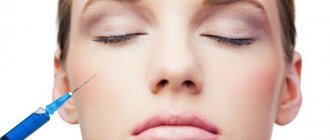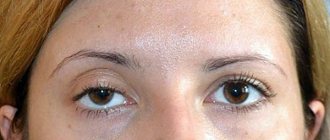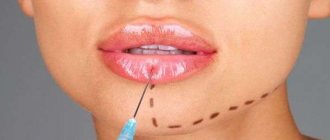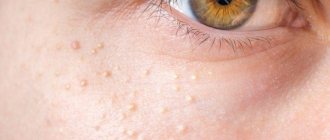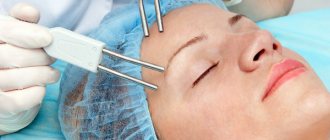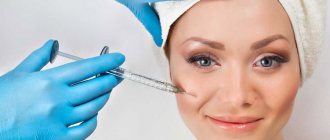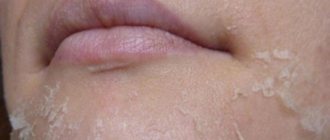Botox is not considered an extremely dangerous procedure, but not everyone is lucky with it. Some girls complain of headaches, signs of allergies and puffiness under the eyes, which in most cases goes away on its own. Let's figure out whether you need to worry about the fact that your eyes look swollen after the procedure and how to bring the appearance back to normal.
Swelling after Botox can be either normal or a deviation from it. How to minimize swelling while waiting for a transformation and regain a healthy appearance if something goes wrong is worth thinking about in advance.
The essence of the procedure
The botulinum toxin drug is injected under the skin with a special thin needle. Botox is based on a poison that does not cause harm in minimal concentrations, but in case of an overdose can lead to serious complications.
The rejuvenation effect is associated with blocking impulses from nerve endings to facial muscles. As a result, muscle mobility decreases: although a person’s face still expresses vivid emotions, they are not accompanied by the formation of age-related folds, which we all dislike so much.
The effect lasts for 6 months or more, during which time the risk of new creases appearing is reduced, no matter how active a person’s facial expressions are.
Treatment of the disease
Most often, ptosis of the upper eyelid, which occurs after Botox injection, does not require any special treatment and goes away on its own within 1-2 months. To speed up the removal of botulinum toxin from the body, additional treatment may be carried out.
Conservative treatment
The main goal of conservative treatment is to restore the functionality of the damaged nerve and is used when a neurogenic form of ptosis is diagnosed after Botox injection. Treatment of the disease is carried out using the following methods:
- face massage;
- conducting local UHF therapy;
- the patch is used to fix the upper eyelid;
- carrying out a procedure such as galvanotherapy, which uses galvanic current;
- laser therapy;
- electrophoresis.
Surgery
Treatment of the disease with surgery is used when it is not possible to achieve a positive result with conservative treatment methods and ptosis of the upper eyelid after the administration of Botox develops into a severe form.
Timely and high-quality treatment will help save the patient from further progression of severe complications and restore the damaged upper eyelid muscle through surgery.
Features of the operation
If ptosis of the upper eyelid is diagnosed after Botox injection, a decision is made to perform surgery, all efforts are directed towards shortening the aponeurosis of the upper eyelid muscle.
The operation is performed under local or general anesthesia and its duration ranges from 30 to 50 minutes. After it, no traces of scars remain on the facial skin, since the wound is sutured using cosmetic sutures and they are removed seven days after the operation.
Most often, there is no need to take analgesics, since the wound does not cause any severe pain. After the operation, a sterile bandage is applied to the resulting wound, which is removed after a few hours.
Types of surgery
All operations can be divided into several types:
- Eversbush's operation is one of the most common types of surgical intervention, which involves the formation of a fold on the levator tendon;
- Mote technique - this operation is the most complex type of surgical intervention and not all cosmetology clinics undertake it. Its essence lies in strengthening the levator function with the help of the upper muscle in the absence of its paralysis;
- Hess operation - this surgical intervention is performed in the presence of levator and superior rectus palsy. In this case, suturing is performed with the transfer of the levator function to the frontal muscle.
Upper eyelid ptosis is one of the unpleasant eye pathologies that can develop after Botox injections. To prevent this disease, it is recommended to carry out procedures using bototoxin preparations only under the supervision of experienced specialists and in specialized clinics. Treatment of lower eyelid ptosis in the early stages of its development will avoid serious complications in the future.
Causes of “unhealthy” swelling
One of the possible reasons is a cosmetologist’s mistake:
- the dosage of the drug is incorrectly calculated;
- the injection points are incorrectly selected;
- No allergy test has been performed beforehand.
Severe swelling can be caused by diseases of the heart, liver, kidneys, blood vessels, hormonal imbalance (if a woman has bags under her eyes before her period, they will continue to appear after the procedure) and specific muscle tone.
Often mistakes are made by clients themselves. “Don’t” applies to the following actions:
- Drinking alcohol in the first hours after the procedure.
- Drinking alcohol before Botox.
- Rubbing, massaging the places where the drug was injected.
- Being in conditions of temperature changes. For example, visiting the sauna.
- Active sports activities.
- Taking antibiotics.
- Sleeping “face into the pillow”, staying in an inclined position for a long time.
Development of ptosis after Botox injections
Botox injections, gaining more and more popularity year after year, are considered by many people as one of the best ways to deal with wrinkles around the eyes when conventional cosmetics no longer bring the desired results. The principle of their action is as follows: after examining the eyelids, a specialist identifies so-called areas of muscle hyperactivity, which relax after injections, due to which the skin around the eyes is smoothed.
However, procedures of this kind have many side effects, which can be quite dangerous to health if ignored. Often one of these possible complications is ptosis of the upper eyelid. This problem most often arises as a result of mistakes made during the injections themselves or incorrect calculation of the dosage of the injected substance, that is, the main reason for the drooping of the upper eyelid after Botox can, first of all, be called the low qualifications of the specialist performing the procedure. In this case, the muscle that is responsible for raising the upper eyelid loses strength and ability to perform its functions.
According to statistics, among all the adverse results of Botox injections, cases of ptosis of the upper eyelid account for at least 20% of the total. But, due to the fact that the effect of the procedure itself is time-limited, this complication gradually disappears even without special therapy. As a rule, signs of drooping eyelids persist for no longer than a month from the date of drug administration. However, it should be taken into account that if there is ptosis of the eyelids even before the procedure, after Botox injections the situation can worsen significantly, which experts do not always warn about in advance.
In any case, drooping eyelids is a pathology that can and is extremely important to treat, for which modern medicine has many effective methods, starting with medications, massage and special exercises and ending with surgery. And the sooner and more accurately the causes of the pathology are determined, the higher the likelihood of getting rid of it or slowing down the process of its development.
Getting rid of puffiness
You can drink diuretics - decoctions of rose hips, hawthorn, Furasemid. This will help eliminate stagnation. It is useful to apply warm compresses to problem areas: you need to dip a cotton cloth in boiled water or chamomile infusion, apply to the swelling, repeat the procedure 2-3 times a day.
Lymphatic drainage massage (manual, hardware) helps relieve swelling and remove harmful substances. It will take about 7 sessions of 10 minutes each.
To remove serious swelling under the eyes after Botox, more energy-intensive measures are carried out, which the doctor will recommend:
- Injections of Neuromidin, Promedin (injected into the sites of Botox injections).
- Succinic acid injections.
- Galvanotherapy is the removal of stagnant fluid using microcurrents.
- Laser therapy.
- Mesotherapy.
❤
When is swelling natural and when is it not?
Fluid accumulation and swelling may be a normal, natural response of the body to damage and injury caused by needle insertion. It is necessary to observe the condition of the swelling for 1-2 days . The swelling caused by the action of the needle will gradually decrease and disappear after 3 days without a trace.
How many days does it take for pathology to appear?
Pathological swelling after Botox may not appear immediately, but after 7–10 days. It is at this time that the toxin begins to act on the muscles and causes them to relax. There is a disruption in the circulation of blood and lymph in the tissues, stagnation of excess fluid occurs, and swelling around the eyes occurs.
We invite you to watch a video about the occurrence of swelling after the Botox procedure:
How to avoid negative consequences
In anticipation of the procedure, it is better to stop taking medications that thin the blood, do not drink alcohol, or smoke: all this can lead to increased bleeding during injections.
And most importantly, you shouldn’t take risks by coming to someone’s home or even a beauty salon for a procedure based on a positive review from a distant relative of a close friend. In the best case, careless injections will cause bruises, in the worst case, an infection can occur. You need to find a clinic with a medical license.
It is recommended to monitor cosmetologists with good ratings in advance, and when meeting in person, ask for proof of medical education and existing certificates.
Beauty is important, but health is certainly no less, so it is better to discard embarrassment and unfounded trust.
Where should the drugs be administered?
Botulinum toxins have been used in cosmetology for quite a long time. During this period, their effect has been well studied. So, there are certain places in the facial part of the skin where the likelihood of swelling is increased. These places include the frontal part and the area of the so-called “crow's feet”. This does not mean that you should refuse to administer the drug to these places. Simply, for such problem areas, a slightly different administration technique is used.
It is the knowledge of such nuances that distinguishes a professional cosmetologist from yesterday’s schoolgirls who attended seminars and learned the approximate location of the main points of drug administration. Naturally, a professional cosmetologist is much less likely to get a bunch of problems associated with complications instead of the expected effect. The most common mistakes that lead to undesirable consequences include:
• Improper preparation of the area and non-compliance with skin care rules during the recovery period; • Incorrect choice of drug dosage. As a rule, a professional cosmetologist always starts work with minimal doses of the drug, gradually increasing them as needed and monitoring the body’s reaction.
Places of swelling
80% of swelling after Botox is under the eyes. This is due to the peculiarity of the skin in this area of the face. Firstly, this place has the thinnest skin. Secondly, it does not lie on a bone frame, but on a layer of loose fatty tissue. It is not difficult for swollen tissues to squeeze small vessels. The greater the swelling, the more the vessels are pinched, the worse the outflow of lymph occurs - this is how a vicious circle turns out. It can be broken by qualified medical assistance. Alas, and only she – the situation will not improve on its own.
The remaining 20% of cases of swelling are all other areas where botulinum toxin can be injected. And the reason for them is, first of all, ignorance of the rules of subcutaneous interpenetration of liquids by the specialist performing the injections. But it’s difficult to call such a person a specialist.
